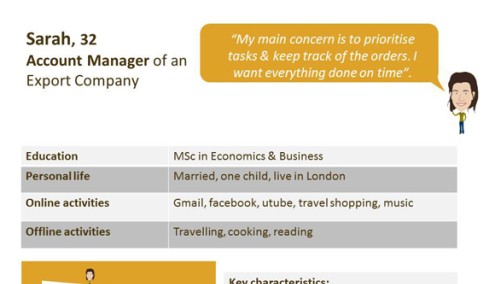How to use personas in web design
How to use personas in web design
As any designer or developer worth their salt will tell you, a successful website is based on an understanding of your end user. Today’s audiences are looking for far more than pretty pictures and a website that works – they want user friendly sites that give them access to high quality information in the easiest and most appropriate ways for them.
Personas are a tried and tested way of ascertaining not only who your audience is but their motivations, needs and expectations of your site. Personas guide creativity and implementation, creating a far more optimised user experience than that born of guess work and assumptions.
What are personas?
Personas are representative profiles of the people who may use your site. They provide a description of the typical users with photos, names and roles which bring them to life. Here's an example persona (view it full-size in a new window):
Personas primarily record the typical behaviours of those users and how they might use your site. As websites usually have more than one group of users, multiple personas are used to give a full overview.
The importance of a good persona
"Personas can deliver a gut check to many parts of your project – business requirements, visual design, or quality assurance - by providing insight into who your audience is and what their expectations and behaviours are," say Russ Unger and Carolyn Chandler in their book, A project guide to UX design.
A good persona will deliver on a number of levels:
- They can guide the project team, encompassing all the requirements combined with user needs
- They allow users' goals to be recorded
- They are the basis of websites which really cater for the needs of the end user, because they focus the design, build and content generation.
Personas should be based on an understanding of the end user, not on the opinion of the designer or developer. This means you need to do your research, perhaps in the form of focus groups, surveys or interviews. These should help you pick out details which you may not otherwise know about your target groups.
The research techniques you use will probably depend on budget and time constraints. The key is to find out as much as possible and use it to your advantage.
Generally, three to seven personas will adequately represent your target group – any more and you risk clouding your insight with useless divisions. Everything you put into your personas should have a tangible outcome for the project, with all insights being a guiding force for key sectors of the design and build.
How to create personas
- Give life to your imaginary users by giving them a name and visual image. Personal information like age, occupation, education, online activities, social comfort level, mobile comfort level and offline activities will all help.
- Avoid being narrative. Try to use bullet points. This helps you focus specifically on user characteristics. The purpose of personas is to make your life easier, not to add extra work to your project.
- Keep persona descriptions short. There is no need to list unnecessary information. Stick to factors which affect - directly or indirectly - user behaviour and project features.
- Avoid creating ideal users. You're creating a website to fit your personas, not personas to fit your website. People are demanding and their needs should be included in personas.
- Don’t forget to include the goal of your end user. Are they trying to buy something? To find information?
- Don’t create one persona that encompasses all your characteristics. Each persona should be realistic - make them a person who could conceivably exist in real life.
Laura Hampton works for Zabisco. Read the Zabisco blog.





Comments
Add a comment